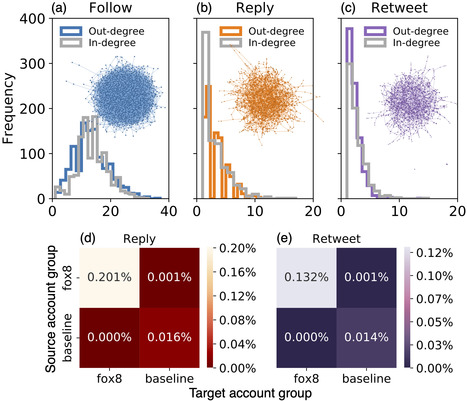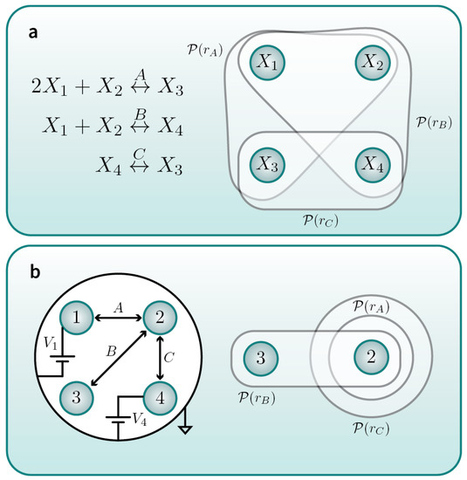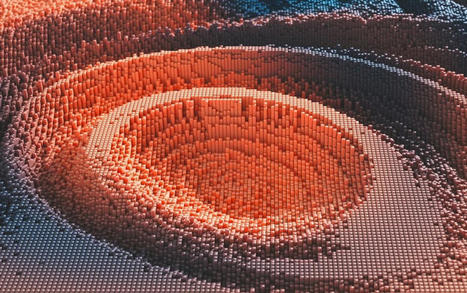 Your new post is loading...
 Your new post is loading...

|
Suggested by
Fil Menczer
August 3, 2023 11:04 AM
|
Large language models (LLMs) exhibit impressive capabilities in generating
realistic text across diverse subjects. Concerns have been raised that they
could be utilized to produce fake content with a deceptive intention, although
evidence thus far remains anecdotal. This paper presents a case study about a
Twitter botnet that appears to employ ChatGPT to generate human-like content.
Through heuristics, we identify 1,140 accounts and validate them via manual
annotation. These accounts form a dense cluster of fake personas that exhibit
similar behaviors, including posting machine-generated content and stolen
images, and engage with each other through replies and retweets.
ChatGPT-generated content promotes suspicious websites and spreads harmful
comments. While the accounts in the AI botnet can be detected through their
coordination patterns, current state-of-the-art LLM content classifiers fail to
discriminate between them and human accounts in the wild. These findings
highlight the threats posed by AI-enabled social bots. Read the full article at: arxiv.org

|
Scooped by
Complexity Digest
July 29, 2023 6:28 PM
|
Eric Lagasse Michael Levin Trends in Molecular Medicine The remarkable anatomical homeostasis exhibited by complex living organisms suggests
that they are inherently reprogrammable information-processing systems that offer
numerous interfaces to their physiological and anatomical problem-solving capacities.
We briefly review data suggesting that the multiscale competency of living forms affords
a new path for biomedicine that exploits the innate collective intelligence of tissues
and organs. The concept of tissue-level allostatic goal-directedness is already bearing
fruit in clinical practice. We sketch a roadmap towards 'somatic psychiatry' by using
advances in bioelectricity and behavioral neuroscience to design methods that induce
self-repair of structure and function. Relaxing the assumption that cellular control
mechanisms are static, exploiting powerful concepts from cybernetics, behavioral science,
and developmental biology may spark definitive solutions to current biomedical challenges. Read the full article at: www.cell.com

|
Scooped by
Complexity Digest
July 22, 2023 4:36 PM
|
Dirk Helbing, Sachit Mahajan, Regula Hänggli Fricker, Andrea Musso, Carina I. Hausladen, Cesare Carissimo, Dino Carpentras, Elisabeth Stockinger, Javier Argota Sanchez-Vaquerizo, Joshua C. Yang, Mark C. Ballandies, Marcin Korecki, Rohit K. Dubey, Evangelos Pournaras Journal of Computational Science Volume 71, July 2023, 102061 The technological revolution, particularly the availability of more data and more powerful computational tools, has led to the emergence of a new scientific field called “Computational Diplomacy”. Our work tries to define its scope and focuses on a popular subarea of it, namely “Digital Democracy”. In recent years, there has been a surge of interest in using digital technologies to promote more participatory forms of democracy. While there are numerous potential benefits to using digital tools to enhance democracy, significant challenges must be addressed. It is essential to ensure that digital technologies are used in an accessible, equitable, and fair manner rather than reinforcing existing power imbalances. This paper investigates how digital tools can be used to help design more democratic societies by investigating three key research areas: (1) the role of digital technologies for facilitating civic engagement in collective decision-making; (2) the use of digital tools to improve transparency and accountability in governance; and (3) the potential for digital technologies to enable the formation of more inclusive and representative democracies. We argue that more research on how digital technologies can be used to support democracy upgrade is needed. Along these lines, we lay out a research agenda for the future. Read the full article at: www.sciencedirect.com

|
Scooped by
Complexity Digest
July 22, 2023 12:14 PM
|
MELANIE MITCHELL SCIENCE Vol 381, Issue 665 In 1967, Marvin Minksy, a founder of the field of artificial intelligence (AI), made a bold prediction: “Within a generation…the problem of creating ‘artificial intelligence’ will be substantially solved.” Assuming that a generation is about 30 years, Minsky was clearly overoptimistic. But now, nearly two generations later, how close are we to the original goal of human-level (or greater) intelligence in machines? Read the full article at: www.science.org

|
Scooped by
Complexity Digest
July 21, 2023 10:00 PM
|
Maria del Rio-Chanona, Nadzeya Laurentsyeva, Johannes Wachs Large language models like ChatGPT efficiently provide users with information about various topics, presenting a potential substitute for searching the web and asking people for help online. But since users interact privately with the model, these models may drastically reduce the amount of publicly available human-generated data and knowledge resources. This substitution can present a significant problem in securing training data for future models. In this work, we investigate how the release of ChatGPT changed human-generated open data on the web by analyzing the activity on Stack Overflow, the leading online Q\&A platform for computer programming. We find that relative to its Russian and Chinese counterparts, where access to ChatGPT is limited, and to similar forums for mathematics, where ChatGPT is less capable, activity on Stack Overflow significantly decreased. A difference-in-differences model estimates a 16\% decrease in weekly posts on Stack Overflow. This effect increases in magnitude over time, and is larger for posts related to the most widely used programming languages. Posts made after ChatGPT get similar voting scores than before, suggesting that ChatGPT is not merely displacing duplicate or low-quality content. These results suggest that more users are adopting large language models to answer questions and they are better substitutes for Stack Overflow for languages for which they have more training data. Using models like ChatGPT may be more efficient for solving certain programming problems, but its widespread adoption and the resulting shift away from public exchange on the web will limit the open data people and models can learn from in the future. Read the full article at: arxiv.org

|
Scooped by
Complexity Digest
July 21, 2023 3:12 PM
|
Gabriele Di Bona, Alessandro Bellina, Giordano De Marzo, Angelo Petralia, Iacopo Iacopini, Vito Latora The Heaps' law, which characterizes the growth of novelties, has triggered new mathematical descriptions, based on urn models or on random walks, of the way we explore the world. However, an often-overlooked aspect is that novelties can also arise as new combinations of existing elements. Here we propose to study novelties as n≥1 consecutive elements appearing for the first time in a sequence, and we introduce the nth-order Heaps' exponents to measure the pace of discovery of novelties of any order. Through extensive analyses of real-world sequences, we find that processes displaying the same pace of discovery of single items can instead differ at higher orders. We then propose to model the exploration dynamics as an edge-reinforced random walk with triggering on a network of relations between items which elvolves over time. The model reproduces the observed properties of higher-order novelties, and reveals how the space of possibilities expands over time along with the exploration process. Read the full article at: arxiv.org

|
Scooped by
Complexity Digest
July 21, 2023 12:50 PM
|
Farita Tasnim and David H. Wolpert Entropy 2023, 25(7), 1078 Many dynamical systems consist of multiple, co-evolving subsystems (i.e., they have multiple degrees of freedom). Often, the dynamics of one or more of these subsystems will not directly depend on the state of some other subsystems, resulting in a network of dependencies governing the dynamics. How does this dependency network affect the full system’s thermodynamics? Prior studies on the stochastic thermodynamics of multipartite processes have addressed this question by assuming that, in addition to the constraints of the dependency network, only one subsystem is allowed to change state at a time. However, in many real systems, such as chemical reaction networks or electronic circuits, multiple subsystems can—or must—change state together. Here, we investigate the thermodynamics of such composite processes, in which multiple subsystems are allowed to change state simultaneously. We first present new, strictly positive lower bounds on entropy production in composite processes. We then present thermodynamic uncertainty relations for information flows in composite processes. We end with strengthened speed limits for composite processes. Read the full article at: www.mdpi.com

|
Scooped by
Complexity Digest
July 13, 2023 5:59 PM
|
Yiding Cao, Yingjun Dong, Minjun Kim, Neil G. MacLaren, Sriniwas Pandey, Shelley D. Dionne, Francis J. Yammarino, Hiroki Sayama Human collectives, e.g., teams and organizations, increasingly require participation of members with diverse backgrounds working in networked social environments. However, little is known about how network structure and the diversity of member backgrounds would affect collective processes. Here we conducted three sets of human-subject experiments which involved 617 participants who collaborated anonymously in a collective ideation task on a custom-made online social network platform. We found that spatially clustered collectives with clustered background distribution tended to explore more diverse ideas than in other conditions, whereas collectives with random background distribution consistently generated ideas with the highest utility. We also found that higher network connectivity may improve individuals' overall experience but may not improve the collective performance regarding idea generation, idea diversity, and final idea quality. Read the full article at: arxiv.org

|
Scooped by
Complexity Digest
July 10, 2023 1:40 PM
|
Klaus Jaffe Emergence, information and energy are fundamental properties of nature. We know that it takes free energy to acquire information, and it takes information to increment free energy. Energy obeys all laws of thermodynamics, while information does not. Emergence occurs in dynamic complex systems: when more than one dimension of reality interacts and novel properties of energy and information emerge. Information can be either useful or not in producing free energy. Information can reveal itself in different forms (as entropy, physically encoded, mechanical, biological, structural, in neural or social networks, etc.). Information may increase free energy by reducing entropy in the system, or by capturing free energy from the surroundings. The interaction between information and energy has been studied mostly in physical-chemistry and engineering. Now we find it everywhere, including in computer sciences, genetics, biotechnology, experimental social sciences, and experimental law. In emergent systems new possibilities of increasing free energy and useful information appear. Emergent complexity is visible in the transitions from subatomic particles to atoms, from atoms to molecules, to cells, to organisms, to societies and ecosystems. General and simple concepts are presented to help untangle the forces behind evolutionary processes leading to ever more complexity with more free energy and useful information, giving birth to life. We need to quantify changes in energy and information to better understand the dynamics of emergence in complex far-from-equilibrium systems. Read the full article at: www.qeios.com

|
Scooped by
Complexity Digest
July 2, 2023 3:09 PM
|
Menachem Stern and Arvind Murugan Annual Review of Condensed Matter Physics Vol. 14:417-441 Learning is traditionally studied in biological or computational systems. The power of learning frameworks in solving hard inverse problems provides an appealing case for the development of physical learning in which physical systems adopt desirable properties on their own without computational design. It was recently realized that large classes of physical systems can physically learn through local learning rules, autonomously adapting their parameters in response to observed examples of use. We review recent work in the emerging field of physical learning, describing theoretical and experimental advances in areas ranging from molecular self-assembly to flow networks and mechanical materials. Physical learning machines provide multiple practical advantages over computer designed ones, in particular by not requiring an accurate model of the system, and their ability to autonomously adapt to changing needs over time. As theoretical constructs, physical learning machines afford a novel perspective on how physical constraints modify abstract learning theory. Read the full article at: www.annualreviews.org

|
Scooped by
Complexity Digest
July 1, 2023 3:08 PM
|
Daniel Andrew Atad Pedro A. M. Mediano Fernando Rosas Aviva Berkovich-Ohana Recent years have seen a growing interest in the use of measures inspired by complexity science for the study of consciousness. The work done in this field has shown remarkable results in discerning conscious from unconscious states, and in characterizing states of altered conscious experience following intake of psychedelic substances as involving enhanced complexity. However, the relationship between meditation and complexity is unclear, as empirical studies based on different theoretical frameworks point to meditation being associated with either enhancement or reduction of complexity. Here we provide a systematic review of the accumulating literature studying the complexity of neural activity in meditation, which disentangles different families of measures, short-term (state) from long-term (trait) effects, and meditation styles. Beyond families of measures used, our review uncovers a convergence toward identifying a higher complexity of neural activity during the meditative state when compared to waking rest or mind-wandering, and a decreased baseline complexity as a trait in experienced meditators compared to novices and controls. This review contributes to guide current debates and provides a framework for understanding the complexity of neural activity in meditation, while suggesting some practical guidelines for future research in the field. Read the full article at: psyarxiv.com

|
Scooped by
Complexity Digest
June 30, 2023 9:04 PM
|
Abeba Birhane, Vinay Prabhu, Sang Han, Vishnu Naresh Boddeti `Scale the model, scale the data, scale the GPU-farms' is the reigning sentiment in the world of generative AI today. While model scaling has been extensively studied, data scaling and its downstream impacts remain under explored. This is especially of critical importance in the context of visio-linguistic datasets whose main source is the World Wide Web, condensed and packaged as the CommonCrawl dump. This large scale data-dump, which is known to have numerous drawbacks, is repeatedly mined and serves as the data-motherlode for large generative models. In this paper, we: 1) investigate the effect of scaling datasets on hateful content through a comparative audit of the LAION-400M and LAION-2B-en, containing 400 million and 2 billion samples respectively, and 2) evaluate the downstream impact of scale on visio-linguistic models trained on these dataset variants by measuring racial bias of the models trained on them using the Chicago Face Dataset (CFD) as a probe. Our results show that 1) the presence of hateful content in datasets, when measured with a Hate Content Rate (HCR) metric on the inferences of the Pysentimiento hate-detection Natural Language Processing (NLP) model, increased by nearly 12% and 2) societal biases and negative stereotypes were also exacerbated with scale on the models we evaluated. As scale increased, the tendency of the model to associate images of human faces with the `human being' class over 7 other offensive classes reduced by half. Furthermore, for the Black female category, the tendency of the model to associate their faces with the `criminal' class doubled, while quintupling for Black male faces. We present a qualitative and historical analysis of the model audit results, reflect on our findings and its implications for dataset curation practice, and close with a summary of our findings and potential future work to be done in this area. Read the full article at: arxiv.org

|
Scooped by
Complexity Digest
June 28, 2023 1:00 PM
|
Ute Deichmann Entropy 2023, 25(6), 873 The debate about what causes the generation of form and structure in embryological development goes back to antiquity. Most recently, it has focused on the divergent views as to whether the generation of patterns and form in development is a largely self-organized process or is mainly determined by the genome, in particular, complex developmental gene regulatory processes. This paper presents and analyzes pertinent models of pattern formation and form generation in a developing organism in the past and the present, with a special emphasis on Alan Turing’s 1952 reaction–diffusion model. I first draw attention to the fact that Turing’s paper remained, at first, without a noticeable impact on the community of biologists because purely physical–chemical models were unable to explain embryological development and often also simple repetitive patterns. I then show that from the year 2000 and onwards, Turing’s 1952 paper was increasingly cited also by biologists. The model was updated to include gene products and now seemed able to account for the generation of biological patterns, though discrepancies between models and biological reality remained. I then point out Eric Davidson’s successful theory of early embryogenesis based on gene-regulatory network analysis and its mathematical modeling that not only was able to provide a mechanistic and causal explanation for gene regulatory events controlling developmental cell fate specification but, unlike reaction–diffusion models, also addressed the effects of evolution and organisms’ longstanding developmental and species stability. The paper concludes with an outlook on further developments of the gene regulatory network model. Read the full article at: www.mdpi.com
|

|
Scooped by
Complexity Digest
July 29, 2023 9:02 PM
|
Sandra González-Bailón, et al. SCIENCE 27 Jul 2023 Vol 381, Issue 6656 Does Facebook enable ideological segregation in political news consumption? We analyzed exposure to news during the US 2020 election using aggregated data for 208 million US Facebook users. We compared the inventory of all political news that users could have seen in their feeds with the information that they saw (after algorithmic curation) and the information with which they engaged. We show that (i) ideological segregation is high and increases as we shift from potential exposure to actual exposure to engagement; (ii) there is an asymmetry between conservative and liberal audiences, with a substantial corner of the news ecosystem consumed exclusively by conservatives; and (iii) most misinformation, as identified by Meta’s Third-Party Fact-Checking Program, exists within this homogeneously conservative corner, which has no equivalent on the liberal side. Sources favored by conservative audiences were more prevalent on Facebook’s news ecosystem than those favored by liberals. Read the full article at: www.science.org

|
Scooped by
Complexity Digest
July 24, 2023 1:58 PM
|
Atsushi Masumori, Takashi Ikegami Biosystems The concept of Learning by Stimulus Avoidance (LSA) has been proposed in recent literature, and this method of avoiding stimuli appears to align well with the formation of Bertschinger’s informational closure. In this study, we provide experimental evidence demonstrating that spiking neural networks, which avoid stimuli, can indeed facilitate the emergence of informational closure. The established link between LSA and informational closure lays the foundation for further exploration of autopoietic relationships and the self-organization of closure within neural networks. Read the full article at: www.sciencedirect.com

|
Scooped by
Complexity Digest
July 22, 2023 12:56 PM
|
L. Barnett and A. K. Seth
Phys. Rev. E 108, 014304 We introduce a notion of emergence for macroscopic variables associated with highly multivariate microscopic dynamical processes. Dynamical independence instantiates the intuition of an emergent macroscopic process as one possessing the characteristics of a dynamical system “in its own right,” with its own dynamical laws distinct from those of the underlying microscopic dynamics. We quantify (departure from) dynamical independence by a transformation-invariant Shannon information-based measure of dynamical dependence. We emphasize the data-driven discovery of dynamically independent macroscopic variables, and introduce the idea of a multiscale “emergence portrait” for complex systems. We show how dynamical dependence may be computed explicitly for linear systems in both time and frequency domains, facilitating discovery of emergent phenomena across spatiotemporal scales, and outline application of the linear operationalization to inference of emergence portraits for neural systems from neurophysiological time-series data. We discuss dynamical independence for discrete- and continuous-time deterministic dynamics, with potential application to Hamiltonian mechanics and classical complex systems such as flocking and cellular automata. Read the full article at: link.aps.org

|
Scooped by
Complexity Digest
July 22, 2023 1:06 AM
|
Tomáš Gonda, Tobias Reinhart, Sebastian Stengele, Gemma De les Coves Turing machines and spin models share a notion of universality according to which some simulate all others. Is there a theory of universality that captures this notion? We set up a categorical framework for universality which includes as instances universal Turing machines, universal spin models, NP completeness, top of a preorder, denseness of a subset, and more. By identifying necessary conditions for universality, we show that universal spin models cannot be finite. We also characterize when universality can be distinguished from a trivial one and use it to show that universal Turing machines are non-trivial in this sense. Our framework allows not only to compare universalities within each instance, but also instances themselves. We leverage a Fixed Point Theorem inspired by a result of Lawvere to establish that universality and negation give rise to unreachability (such as uncomputability). As such, this work sets the basis for a unified approach to universality and invites the study of further examples within the framework. Read the full article at: arxiv.org

|
Scooped by
Complexity Digest
July 21, 2023 4:59 PM
|
Diego Rybski & Antonio Ciccone Archive for History of Exact Sciences (2023) Power-law city-size distributions are a statistical regularity researched in many countries and urban systems. In this history of science treatise we reconsider Felix Auerbach’s paper published in 1913. We reviewed his analysis and found (i) that a constant absolute concentration, as introduced by him, is equivalent to a power-law distribution with exponent ≈1, (ii) that Auerbach describes this equivalence, and (iii) that Auerbach also pioneered the empirical analysis of city-size distributions across countries, regions, and time periods. We further investigate his legacy as reflected in citations and find that important follow-up work, e.g. by Lotka (Elements of physical biology. Williams & Wilkins Company, Baltimore, 1925) and Zipf (Human behavior and the principle of least effort: an introduction to human ecology, Martino Publishing, Manfield Centre, CT (2012), 1949), does give proper reference to his discovery—but others do not. For example, only approximately 20% of city-related works citing Zipf (1949) also cite Auerbach (Petermanns Geogr Mitteilungen 59(74):74–76, 1913). To our best knowledge, Lotka (1925) was the first to describe the power-law rank-size rule as it is analyzed today. Saibante (Metron Rivista Internazionale di Statistica 7(2):53–99, 1928), building on Auerbach and Lotka, investigated the power-law rank-size rule across countries, regions, and time periods. Zipf’s achievement was to embed these findings in his monumental 1949 book. We suggest that the use of “Auerbach–Lotka–Zipf law” (or “ALZ-law”) is more appropriate than “Zipf’s law for cities”, which also avoids confusion with Zipf’s law for word frequency. We end the treatise with biographical notes on Auerbach. Read the full article at: link.springer.com

|
Scooped by
Complexity Digest
July 21, 2023 3:01 PM
|
Philip C. Ball Speculation about conditions on Venus raises questions about our existing definitions Read the full article at: www.chemistryworld.com

|
Scooped by
Complexity Digest
July 14, 2023 6:01 PM
|
Daniele Carlesso, Justin M. McNab, Christopher J. Lustri, Simon Garnier, and Chris R. Reid PNAS 120 (29) e2216217120 Weaver ants link their bodies together to form chains over gaps and reach unexplored territories. The decision to join or leave a chain is made by individuals, but has cost implications at the colony level, as longer chains sequester more ants, which cannot perform other tasks. Furthermore, the payoff of a chain remains unknown until it is complete and the new area is explored. We demonstrate that individual ants modulate the time they spend in the chain based on their proximity to the ground and that this local behavioral rule caps the colony-level investment into chains. Our theoretical model offers insights into collective decision-making in the absence of payoff information, and could prove useful in the engineering of multiagent systems. Read the full article at: www.pnas.org

|
Scooped by
Complexity Digest
July 12, 2023 1:40 PM
|
Marc Barthelemy Reports on Progress in Physics Stochastic equations constitute a major ingredient in many branches of science, from physics to biology and engineering. Not surprisingly, they appear in many quantitative studies of complex systems. In particular, this type of equation is useful for understanding the dynamics of urban population. Empirically, the population of cities follows a seemingly universal law - called Zipf's law - which was discovered about a century ago and states that when sorted in decreasing order, the population of a city varies as the inverse of its rank. Recent data however showed that this law is only approximate and in some cases not even verified. In addition, the ranks of cities follow a turbulent dynamics: some cities rise while other fall and disappear. Both these aspects - Zipf's law (and deviations around it), and the turbulent dynamics of ranks - need to be explained by the same theoretical
framework and it is natural to look for the equation that governs the evolution of urban populations. We will review here the main theoretical attempts based on stochastic equations to describe these empirical facts. We start with the simple Gibrat model that introduces random growth rates, and we will then discuss the Gabaix model that adds friction for allowing the existence of a stationary distribution. Concerning the dynamics of ranks, we will discuss a phenomenological stochastic equation that describes rank variations in many systems - including cities - and displays a noise-induced transition. We then illustrate the importance of exchanges between the constituents of the system with the diffusion with noise equation. We will explicit this in the case of cities where a stochastic equation for populations can be derived from first principles and confirms the crucial importance of inter-urban migrations shocks for explaining the statistics and the dynamics of the population of cities. Read the full article at: iopscience.iop.org

|
Scooped by
Complexity Digest
July 10, 2023 1:31 PM
|
R Alexander Bentley, Benjamin Horne, Joshua Borycz, Simon Carrignon, Garriy Shteynberg, Blai Vidiella, Sergi Valverde, Michael J O’Brien
Adaptive Behavior Diversity of expertise is inherent to cultural evolution. When it is transparent, diversity of human knowledge is useful; when social conformity overcomes that transparency, “expertise” can lead to divisiveness. This is especially true today, where social media has increasingly allowed misinformation to spread by prioritizing what is recent and popular, regardless of validity or general benefit. Whereas in traditional societies there was diversity of expertise, contemporary social media facilitates homophily, which isolates true subject experts from each other and from the wider population. Diversity of knowledge thus becomes social division. Here, we discuss the potential of a cultural-evolutionary framework designed for the countless choices in contemporary media. Cultural-evolutionary theory identifies key factors that determine whether communication networks unify or fragment knowledge. Our approach highlights two parameters: transparency of information and social conformity. By identifying online spaces exhibiting aggregate patterns of high popularity bias and low transparency of information, we can help define the “safe limits” of social conformity and information overload in digital communications. Read the full article at: journals.sagepub.com

|
Scooped by
Complexity Digest
July 1, 2023 7:25 PM
|
Jisung Yoon, Chris Kempes, Vicky Chuqiao Yang, Geoffrey West, Hyejin Youn For a collective to become greater than the sum of its parts, individuals' efforts and activities must be coordinated or regulated. Not readily observable and measurable, this particular aspect often goes unnoticed and understudied in complex systems. Diving into the Wikipedia ecosystem, where people are free to join and voluntarily edit individual pages with no firm rules, we identified and quantified three fundamental coordination mechanisms and found they scale with an influx of contributors in a remarkably systemic way over three order of magnitudes. Firstly, we have found a super-linear growth in mutual adjustments (scaling exponent: 1.3), manifested through extensive discussions and activity reversals. Secondly, the increase in direct supervision (scaling exponent: 0.9), as represented by the administrators' activities, is disproportionately limited. Finally, the rate of rule enforcement exhibits the slowest escalation (scaling exponent 0.7), reflected by automated bots. The observed scaling exponents are notably robust across topical categories with minor variations attributed to the topic complication. Our findings suggest that as more people contribute to a project, a self-regulating ecosystem incurs faster mutual adjustments than direct supervision and rule enforcement. These findings have practical implications for online collaborative communities aiming to enhance their coordination efficiency. These results also have implications for how we understand human organizations in general. Read the full article at: arxiv.org

|
Scooped by
Complexity Digest
July 1, 2023 1:28 AM
|
Caleb A. Scharf The discovery that life on Earth looks a lot like information propagating itself offers new clues, and new directions, to the hunt for life elsewhere Read the full article at: www.scientificamerican.com

|
Scooped by
Complexity Digest
June 30, 2023 5:34 PM
|
Your brain is not the root of cognition. Read the full article at: nautil.us
|



 Your new post is loading...
Your new post is loading...














